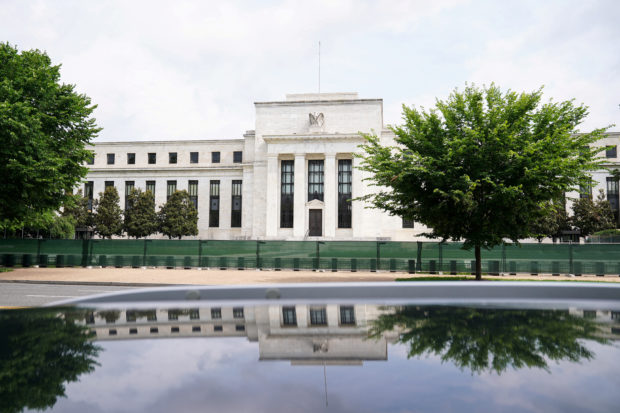Foreign banks amass reserves at the Fed, bracing for funding stress

The exterior of the Marriner S. Eccles Federal Reserve Board Building is seen in Washington, D.C., U.S., June 14, 2022. REUTERS/Sarah Silbiger/File photo
NEW YORK – Foreign bank units have been accumulating cash reserves at the Federal Reserve, likely reflecting concerns that a dollar funding crunch could be looming as the U.S. central bank reduces its balance sheet and global economies face recession risks.
While their reserves were drawn down in September, probably due to quarter-end rebalancing, analysts expect foreign banks to ramp them up again in coming weeks, which could help them avert a disruptive scramble for dollars like the one that occurred three years ago. This may also have implications for how the Fed manages overnight reserves.
The latest Fed data on banks’ assets and liabilities showed cash holdings of foreign banking organizations (FBOs), a proxy for their reserve balances, rose back to $1.2907 trillion as of Oct. 5. The August peak of $1.405 trillion was up roughly 18 percent from the same period last year.
“Foreign banks’ behavior is consistent with an expectation of funding pressure at some point, whether it’s the Fed in the midst of balance sheet reduction or the year-end demand for liquidity,” said Isfar Munir, U.S. economist at Citi in New York.
Analysts are not seeing signs of a serious funding crisis just yet, but said financial institutions could be anticipating one.
The International Monetary Fund warned last week of a disorderly repricing in markets, as global financial instability has increased, raising contagion risks and spillovers of stress between markets.
Inflows into FBOs from parent banks
Inflows to FBOs from their parent banks, has also grown, Fed data showed. As of Oct. 5, “Net due to related foreign offices” was $650.5 billion, up 14 percent from the previous week and just below $673 billion hit in early September, which exceeded the highs seen in 2014.
Analysts believe foreign parent banks are likely borrowing dollars from offshore sources, such as the cross-currency swaps market, which has seen huge dollar demand, and funneling them to their U.S. branches. FX swaps allow investors to raise funds in a particular currency, such as the dollar, from other funding units like the euro.
The cross-currency basis swap, or relative premium for swapping foreign currencies into dollars has widened over the last few weeks. The three-month euro cross rate hit -43.625 basis points (bps) on Monday, not far from the two-year peak of -55.50 touched last week.
“I think parent banks believe it’s cheaper to get dollar funding right now and hold it at the Fed through the branches in case they need it later if there is a funding problem,” Citi’s Munar said.
Quantitative tightening
The Fed has embarked on a quantitative tightening (QT) program, meant to drain pandemic-era stimulus from the financial system. Yet, as it continues with QT, its balance sheet remains huge at $8.759 trillion, as of last week.
Quantitative easing (QE) during the pandemic expanded the Fed’s balance sheet by trading Treasury and other securities for cash, boosting bank reserves deposited at the central bank as well. So when the Fed embarked on QT, the expectation was that bank reserves held at the Fed would decline.
But the decline in bank reserves has been more rapid than what some had anticipated. As of Oct. 5, bank reserves at the Fed fell under $3 trillion to $2.972 trillion, down roughly $1.3 trillion from a peak of $4.3 trillion in December 2021.
In the Fed’s previous QT cycle, $1.3 trillion in liquidity was withdrawn in five years, analysts said.
In September 2019, reserves dwindled to dangerous levels due to heavy withdrawals for tax payments and settlement of Treasury purchases at auctions. That forced the Fed to provide additional reserves to the banking system.
As bank reserves decline during QT, the Fed’s presumption is that a lot of that surplus cash will come from the overnight reverse repo (RRP) facility, analysts said.
In a domestic RRP, investors lend overnight cash to the Fed at an interest rate of 3.05 percent , in exchange for Treasuries or other government securities, with a promise to buy them back.
RRP demand, however, has proven to be sticky, with daily volume hitting north of $2 trillion in the last several months.
“Attempts to lower RRP usage by reducing counterparty limits or the rates on offer, may undermine efforts to tighten monetary policy by pushing down short-term rates,” said Andrew Hunter, senior U.S. economist at Capital Economics.
As domestic bank reserves diminish, those held by FBOs at the Fed have gotten more scrutiny.
Analysts said foreign banks’ increased appetite for dollar liquidity could also be a function of the 3.15 percent paid by the Fed for those assets, or the so-called interest on reserve balances (IORB).
“If there are structural reasons that make foreign banks more eager to hold reserves while large domestic banks’ reserves declined, then there may be a risk of another inadvertent case of gridlock,” said Lou Crandall, chief economist, at money market research firm Wrightson.
“We’re not at that point yet…But it’s something to look out for.”